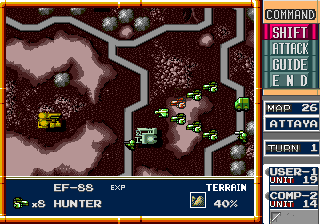|
introduction
& background information: |
In other sections of this site, I have argued that 1994's Neo Nectaris is
the "oddball" title whose peculiarities make it stand out from
the rest of the series. While I still maintain that position, I have
to say that this German version of Nectaris
is also an "oddball"
that really stands out from the rest of the series. Actually, to be
more precise, the German version of Nectaris is the bastard child
of the series. Whereas Neo Nectaris was a true sequel to
1989's Nectaris (by maintaining fundamental elements of the original
game), the German version re-formulates and re-mixes key elements of the
game:
|
1989
Screen Layout |
1995
Screen Layout |
|
|
 |
 |
|
|
1989's
original Nectaris for PC-Engine. Battles are limited to the
Moon, and only 23 different weapons are available. (NOTE: The
North American version for TurboGrafx-16 is pictured above). |
1995's
German update of Nectaris for IBM PC (PC-DOS). The screen
layout remains virtually identical to the 1989, but the in-game
graphics have been completely overhauled. |
|
(1) combat is no longer limited to the lunar landscape -- two new
planets have been added to the Nectaris universe, thereby allowing the introduction of new weapons (i.e. naval
craft and helicopters) and combat that you would never find on a lunar
battlefield, and (2) a complete aesthetic overhaul that replaces the drab weapons
and dreary atmosphere of the Moon with re-styled "cute" weapons set
atop a colorful, vibrant topography.
|

|
These alterations to the classic Nectaris
formula are easier to understand when you look at the production history
of the game. Unlike the other titles in the series (which were
developed by Hudson Soft of Japan), this PC version was developed (level
design, artwork, programming, etc.) by a German team... although Hudson
Soft (Japan) is credited with some of the programming / computer
intelligence (for the core game engine, I assume) and Hudson Soft
(Europe) is credited as one of the title's producers. The German
development team clearly wanted to do more than simply port the original
Nectaris, they wanted to reinvigorate the original game and make it seem
fresh and new. As a result, this
|

|
installment has a somewhat
different look and feel when compared to the rest of the series (check
out screenshot
1 and screenshot
2 to see how maps and weapons have been stylized in this
version) ... plus, it has the most diverse gameplay with 3 worlds, 98
maps, and many unique units you won't find in other Nectaris
titles, such as helicopters, paratroopers, bunkers, jet-pack
infantry, submarines, sea mines, and countless watercraft. Naval warfare
is atypical of the Nectaris series. You begin your campaign
on the Moon (inexplicably referred to as "Triton" in this
version) playing the original 32 maps, then the battle shifts
to another planet -- Romulous -- for the second campaign (32 maps),
before ending up on planet Pacifica for the final 36 maps. I
appreciate the fresh approach taken by the German developers (and I am
already on record as being a fan of "cute" strategy games like Earth Light).
|

|
TRIVIA -- How do the TurboGrafx-16
& German versions of Nectaris break with tradition? : In keeping
with tradition, the original 32 maps of the 1989 Nectaris campaign is included on this release
(but for some inexplicable reason, it is referred to as
"Triton"). Interestingly, however, the German developers BROKE with
tradition when they devised the passwords for this release. Normally,
the passwords for the second-half of the campaign are the same as the
first-half, but in reverse (i.e. if a map is named "REVOLT", then
its counterpart will be "TLOVER"). Instead, the German
developers used the map names from Military Madness (1989,
TurboGrafx-16, North America).
When Nectaris was released in North America for the TG-16
under the title "Military Madness", 18 passwords were altered. The passwords for
the entire advanced campaign (maps 17-32) were
changed for the
TG-16 title. I think the latter was a good idea, since it made it more difficult
to advance by cheating (i.e. simply reversing the map names from the first
campaign). In addition, Map 9 changed from "GALOIS" to
"GALIOS" (to confuse matters, the German version keeps
the original "GALOIS") and map 14 "APPOLO" was corrected to
"APOLLO" (here, the German version
uses "APOLLO").
So, for example, the TG-16 and German versions of Nectaris have
"MILTON" instead of "TLOVER" as a name for stage
17. Needless to say, these passwords do not work with the Japanese
versions of NECTARIS.
|